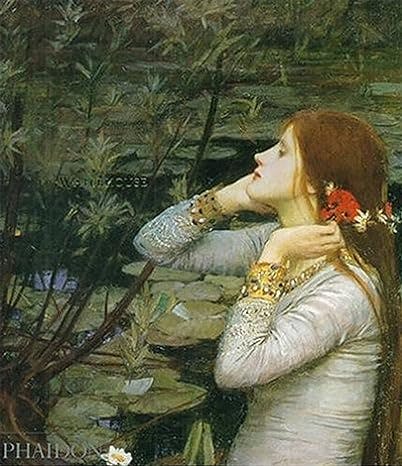John William Waterhouse Symposium at Tate Britain
By Scott Thomas Buckle
On the 10th of October 2002, Tate Britain held a one day Symposium dedicated to John William Waterhouse, timed to coincide with the publication of a new monograph J W Waterhouse by Peter Trippi.

JW Waterhouse by Peter Trippi, Phaidon Press
Speakers included Elizabeth Prettejohn, Christopher Newall, Julia Thomas, Alan Powers, Peter Trippi, Robert Upstone and the writer Colin Wilson. Themes included Waterhouse and the Classical Revival, the Waterhouse woman, Waterhouse's absorption of French techniques, and his fascination with ceremonial magic and the transformations celebrated by Tennyson and Keats.
A Review of the Waterhouse Symposium
JOHN WILLIAM WATERHOUSE RA
SYMPOSIUM AT TATE BRITAIN
THURSDAY 10 OCTOBER 2002
The Symposium on John William Waterhouse featured seven speakers, introduced by the gallery's Joanna Banham. First up was Peter Trippi of the Brooklyn Museum, New York, who provided an overview of Waterhouse's life and art, detailing the painter's early career, his painting technique, his involvement with other artists of the Primrose Hill circle, and the influence of the 1886 Millais exhibition upon his art. He also spoke of a possible connection with the occult Order of the Golden Dawn, of the artist's mysterious model Muriel Foster and of the recently rediscovered painting 'Gather ye Rosebuds while ye may'. The talk was beautifully illustrated throughout with slides from Trippi's book, as well as from other sources.
The late John Physick and Peter Trippi
Elizabeth Prettejohn, Professor of Modern Art at the University of Plymouth, discussed Waterhouse's classicism, focusing not only upon his works inspired by Homer and Ovid, but upon those illustrating more domestic scenes of Roman life. She pointed out the proliferation of children in his early paintings and the dark nature of such scenes as the martyrdom of the twelve year old St Eulalia, in contrast to the more palatable subject matter of Alma Tadema's canvases of the same period.
Novelist Colin Wilson confessed that he had never seen Waterhouse's pictures before in colour, but had gone on a detective trail, armed with a proof copy of Peter Trippi's book to try and discover the occult influence behind Waterhouse's paintings. A rather off-beat summary ensued, including references to Osbert Sitwell and W.B Yeats, in particular the latter's connections with the Order of the Golden Dawn, and some philosophical perspectives upon attitudes to the spirit world during Victorian times.
After lunch, author Julia Thomas, who teaches at Cardiff University, focused her lecture upon paintings of Shakespearean heroines by Waterhouse – principally Cleopatra, Miranda and Ophelia. She explored the diverse interpretations of the same subject in different canvases by Waterhouse, and of how non-narrative illustrations unrelated to the individual play texts could still provide a recognisable depiction of the characters from Shakespeare's plays.
Writer and curator Christopher Newall proceeded to argue that Waterhouse's art was a hybrid of the Leighton and Burne-Jones schools of art, citing the obvious influence of the Rossetti, Hunt and Millais exhibitions of the 1880s upon the young artist's output, but also his continuing loyalty to the Royal Academy. Nevertheless, Newall rightly pointed out that Waterhouse was not generally considered as a 'Pre-Raphaelite' by his contemporaries and was quite unlike other more rebellious artists who were exhibiting at the Dudley Gallery and the Grosvenor Gallery at the time.
Tate Curator Robert Upstone looked at the French influences upon Waterhouse's art, exploring his connection, through his friendship with William Logsdail, to Bramley, Stanhope-Forbes, La Thangue and other members of the Newlyn School of painters. Whilst the choice of subject matter from Keats and Tennyson was that favoured by the Pre-Raphaelite Brotherhood and their followers, Waterhouse's style and technique in these pictures was more akin to that of the naturalist Bastien-Lepage and his followers.
Lecturer Alan Powers spoke of the early history of the Art Workers Guild, of which Waterhouse was a member from 1886. As Honorary Archivist to the Guild, Powers looked into the possible reasons for Waterhouse's resignation in the 1890s and provided a useful insight into the work of fellow members including Crane, Clausen, Strang, Poynter and Blake Richmond. He also pointed out that membership was not limited just to painters and proceeded to explore the rich variety of other crafts that were and are encouraged by the Guild.
At the end of the Symposium, a question and answers forum allowed members of the audience to contribute their own thoughts about Waterhouse and to comment upon what had been said by the various speakers during the day. It was concluded that whilst Waterhouse's popularity is once again in the ascendant, many details of his private life still remain elusive. A continuing theme of mystery and the occult seemed to be present throughout the day, making it clear that there are many questions about the artist that may never be answered.
Peter Trippi signing copies of his book
The Symposium was followed by a reception at the Gallery, supported by Phaidon Press, which served as a book launch for Peter Trippi's new monograph on Waterhouse. The author signed copies of his book and the 80 or so guests were afforded a chance to speak more informally with him and the other guest lecturers over a glass of wine. A pleasurable conclusion to what proved to be a most interesting and informative day for scholars and lovers of John William Waterhouse's art.
Scott Thomas Buckle
11 X 02